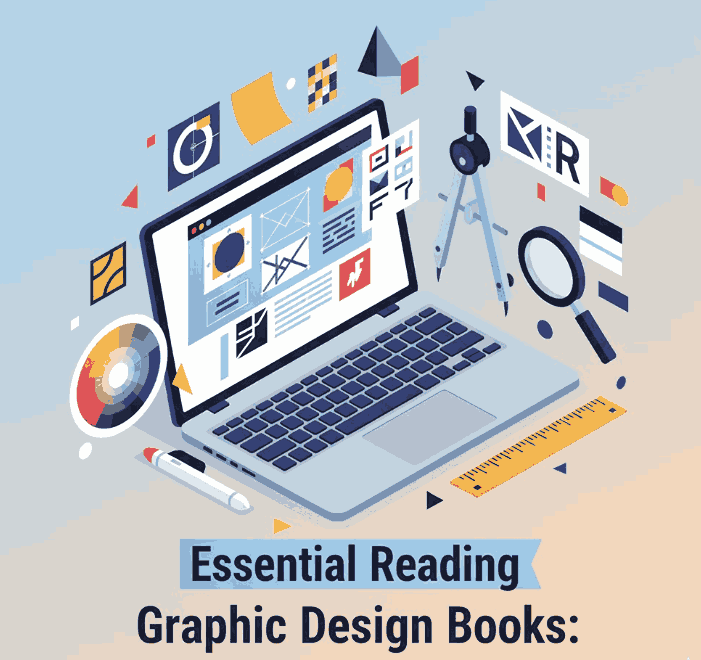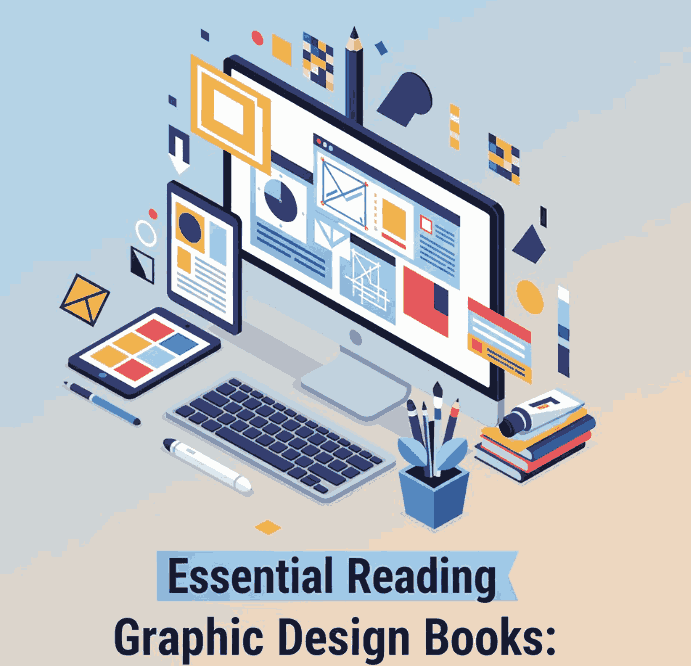
Table of Contents
- Introduction
- Why Reading Matters for Designers
- The Timeless Value of Graphic Design Books
- Must-Have Books for Every Designer
- 4.1 “Thinking with Type” by Ellen Lupton
- 4.2 “Grid Systems in Graphic Design” by Josef Müller-Brockmann
- 4.3 “Logo Modernism” by Jens Müller
- 4.4 “Interaction of Color” by Josef Albers
- 4.5 “Made You Look” by Stefan Sagmeister
- How to Apply Lessons from Design Books in Practice
- Typography and Font Choice in Book and Design Projects
- Featured Fonts from CalligraphyFonts.net
- Conclusion
- References
1. Introduction
Essential Reading Graphic Design In the digital age where tutorials and quick videos dominate, books remain one of the most powerful learning tools for designers. Reading helps refine your design thinking, expand creative perspectives, and improve visual literacy.
This article explores the essential graphic design books every designer should read — whether you’re a beginner mastering typography or an experienced creative seeking deeper theory. We’ll also show how professional fonts can complement your projects and make your design work stand out.

2. Why Matters for Essential Reading Graphic Design
Great design goes beyond aesthetics — it communicates ideas, evokes emotions, and builds connections. Books provide the historical context and theoretical foundations that every designer needs.
Unlike short online content, design books offer structured knowledge, expert perspectives, and timeless inspiration. They help you understand the “why” behind every creative decision — from typography choice to layout balance.
3. The Timeless Value of Essential Reading Graphic Design Books
Graphic design books serve as both inspiration and guidance. They explore the principles of color, typography, grid systems, and branding — subjects that define great design across all eras.
By reading the right books, designers can:
- Improve their design vocabulary and conceptual depth.
- Learn how to analyze composition, hierarchy, and visual flow.
- Gain exposure to historic and modern design movements.
- Build critical thinking and storytelling through design.
Books are the ultimate teacher for those seeking mastery in graphic communication.
4. Must-Have Books for Every Designer
4.1 “Thinking with Type” by Ellen Lupton
Typography is the heartbeat of design, and Lupton’s classic work is a must-read. It teaches how type interacts with structure and emotion, offering real-world examples for both print and digital media.
4.2 “Grid Systems in Graphic Design” by Josef Müller-Brockmann
A cornerstone of Swiss design philosophy, this book provides timeless lessons on structure, rhythm, and proportion. Every professional designer should understand grid systems before diving into modern layouts.
4.3 “Logo Modernism” by Jens Müller
This visual encyclopedia explores how logos evolved through history. It’s a treasure for brand designers and students learning minimalist design systems.
4.4 “Interaction of Color” by Josef Albers
Color theory can make or break your design. Albers’s work shows how colors interact and influence perception — essential reading for anyone who works with branding, illustration, or UI.
4.5 “Made You Look” by Stefan Sagmeister
Sagmeister’s book dives into creativity and the emotional power of design. It reminds designers that aesthetics should always connect to human experience.
5. How to Apply Lessons from Essential Reading Graphic Design Books in Practice
Reading is only valuable when applied. Start by experimenting with what you learn:
- Analyze typography: Observe how spacing and type hierarchy influence message clarity.
- Create grid-based layouts: Apply Müller-Brockmann’s principles in real projects.
- Experiment with color interaction: Use Albers’s exercises to explore color balance and harmony.
- Develop storytelling: Integrate Sagmeister’s emotional design ideas into client projects.
When combined with modern tools and resources, these lessons transform your creative process.
6. Typography and Font Choice in Book and Design Projects
Typography is one of the most powerful elements in both graphic and editorial design. A carefully chosen font can amplify tone, readability, and emotional appeal.
For instance:
- Serif fonts evoke trust and tradition — ideal for print publications.
- Script fonts bring elegance and creativity — perfect for covers or branding.
- Sans-serif fonts feel modern and clean — suited for digital reading experiences.
Choosing the right font connects the visual and emotional aspects of a design, making your message resonate stronger.

7. Featured Fonts from CalligraphyFonts.net
To elevate your next design or book project, here are some stunning fonts available on CalligraphyFonts.net:
- Neitherly Font – A refined and modern calligraphy typeface perfect for elegant book titles and cover headings.
- Rutinitas Font – Graceful and flowing, ideal for adding artistic flair to editorial layouts.
- Signatory Font – Stylish and versatile; works beautifully for author names, chapter titles, or creative taglines.
- Rellative Font – Clean yet expressive script suitable for design quotes or promotional visuals.
Each of these fonts adds personality and balance to any design, helping you convey emotion and sophistication — just like the best design books teach.
8. Conclusion
Investing time in Essential Reading Graphic Design Books is like sharpening your creative toolkit. They offer wisdom that online tutorials can’t replicate — deep insights into type, form, and visual storytelling.
Pair your learning journey with high-quality fonts from CalligraphyFonts.net to transform ideas into polished, professional visuals.
Because great designers don’t just create — they study, refine, and evolve through the art of continuous learning.
9. References
- AIGA Eye on Design – Must-Read Books for Designers
- Envato Tuts+ – 20 Essential Graphic Design Books
- DinStudio – 6 Must-Have Best Graphic Design Books: A List of Recommendation
